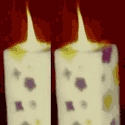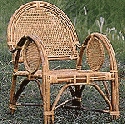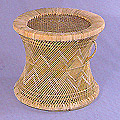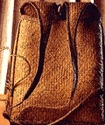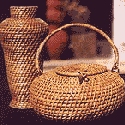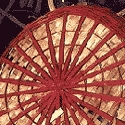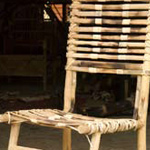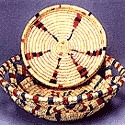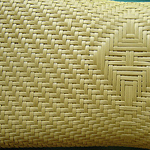Candle making is practiced all across India. However, there are always regional variations present.
Candles are used in Goa at Christian rituals, at rites of passage - baptisms and weddings - and festive occasions in Goa - across Churches and at home candles are lit and used. Menawati or candle making is a traditional craft. Made by pouring molten wax (earlier beeswax collected in the jungles) into moulds in which there is a cotton wick, the other process followed is by pouring molten wax down a wick. White candles and arrange of other color candles are made using chemical color additives. Candles are made by local people across Goa but mainly in the North in Divar Island and Calangute.
Candle making is practiced all across India. However, there are always regional variations present.
Candle making is practiced all across India. However, there are always regional variations present.
Throughout Bhutan, cane and bamboo products have always complemented wood as the most commonly used material to produce items of everyday use. Cane and bamboo have been made into storage containers, baskets for carrying food, utensils, musical instruments, bows and arrows, walls for houses, fences, ropes, and floor mats. The abundant and lush forests in the Himalayan foothills provide the raw material. Over a hundred varieties of cane and bamboo plants thrive in the rain fed forests and are often combined with hard and soft wood from the oak, cedar, maple walnut, and other varieties of wood. The bamboo or rattan is cut into thin strips, braided, and coloured to form geometric designs; sometimes the natural colouring is left as is. The colours used include yellow, green, natural brown-green, blue-purple, and maroon.
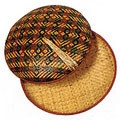
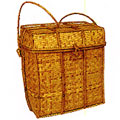

- Tsezem: Basket These baskets are used to store dried meat and carry all kinds of food and articles and often used as shopping bags.
- Lakchung: Basket Traditionally used as a fruit container and for serving dry food items on special occasions and ceremonies. This basket is multi-purpose and is often used as a waste-paper basket or a flower vase.
- Beykhur: Gift Box This basket has a square shape and is traditionally used for storage of yarns.
- Bello: Hat The bello is used by farmersto protect themselves from sun and rain.
- Bangchu: Round Bamboo Plate The Bangchu is traditionally used as a rice plate and for carrying pack-lunches. Also used as a container for serving snacks.
- Poe: Incense Sticks Incense sticks are used daily as offerings to Buddhas, Bodhisattvas, and protective deities and celestial beings. Zurpoe is a Special Incense prepared according to ancient traditions using a blend of more than one hundred precious aromatic and medicinal substances like nagi (scale of Pangolin), musk, red and white sandalwood, giwang (Bezoar), clove, nutmeg, saffron etc...
- Poe Palang: Incense Container These are used for storing incense sticks (poe) in dzongs, monasteries, and households all over the country.
- Jatsa: Tea Strainer Sieves made of plain bamboo are traditionally used for straining butter-tea and milk in Bhutanese households.
- Sipa: Butter & Cheese Container Made of wood and bamboo, these containers were traditionally used to hold butter and cheese. It is ususally either round or oval in shape.
- Palang: Alcohol and Water Container Made of bamboo - they are traditionally used to store and serve alcohol and water.
- Zhu: Bow & Dha: Arrows The Bhutanese arrow (dha) is made of bamboo with a feather-head and metal point.The Bhutanese bow (zhu) is made from a bamboo species prevalent in the foothills of Bhutan. The best bamboo is found in the villages of Taba and Damtey in Samtse.
- Soray Palang: Quiver Traditionally the quiver is made of wood and bamboo.
- Dala Is used for dehusking rice.
- Mats Finely woven mats are a common and popular craft item. Split cane is used in its natural colour or dyed to form patterns. Mats can be found in almost any size up to about 16 square feet.
Traditionally, the Mahar community makes bamboo products that are used by fishermen for functional purposes. Bamboo is locally available, in Pernem, Bicholim, Bardez, Tiswadi, and Sattari districts of Goa while the craft is practiced in the South Goa districts of Madgaon and Cuncolim; and the North Goa districts of Porvorim, Pernem, Bicholim and Mangueshi. The products are available in the weekly markets and in all the markets across Goa.
To craft the bamboo the craftsmen soak the bamboo for two or three days in sea water for seasoning, it is then sun-dried. When completely dry it is segmented. The outermost layer of the bamboo or skin is removed completely. The pith inside is removed and used as fuel. The bamboo is then cut into strips. These strips are further cut into splits that are used for weaving the basket. The baskets are made only with the inner part. The tools used are basic and include the Koyto-large knife and the Sun or small blunt knife. To colour the splits, chemical colours are boiled in water, and the strips are left in this solution for half an hour and dried.
A huge range of utility products like baskets, boxes, flower vases, winnowing trays, chicken baskets, grain baskets, partitions, fans, and mats are made from bamboo strips in Goa.
The history of the bamboo reed industry of Kerala may be traced to the 14th century when the Arab traveler, Ibn Batuta, recorded the use of bamboo mats as sails on the Chinese ships at Kozhikode. This most utilitarian yet critical craft of weaving reed baskets and mats is practiced across Kerala though the largest concentration of craftspeople is in Angamally, Thiruvananthapuram, Dedunganda, Aryanad in Ernakulam district and in Malapuram. Other areas of production include Kodali in Thrissur district; Nileswaram and Malapura. The basketry of Kerala is largely made by the Christian communities of Ernakulam and Thrissur. Traditionally, however, it was the Parayas and Kaatakaras (literally, forest people) of Anapandan, a hillside near Thrissur who undertook the making of cane and bamboo baskets using plain, twill and occasionally the hexagonal weave. A large range of painted and woven mats that are crafted are in great demand all over India. The main centre for this craft is Irinjalakuda. The thick bamboo locally known as mula and the thinner bamboo called eeta are made into rough bamboo mats used as wall partitions and softer grass mats to sleep on. Kotta or rough work baskets with short handles are often reinforced with coir; vatti or neatly woven square baskets made with slim bamboo splits are used for shopping, storage as well as a makeshift vessel. The products are usually daubed over or smoked. A wide variety of decorative baskets and shopping bags, bamboo-reed table mats, and other articles are crafted with the craftspeople producing the reed baskets and mats for a wide range of uses suitable to farming, fishing and other activities and requirements of the villages from mats for drying grain, peppercorns, coconut kernels and fish; baskets for vegetable and fish vendors to carry their wares to the local market; muram the winnowing basket for separating chaff; baskets for storing grain; as table mats, wall hangings, table top products like fruit baskets etc. The bamboo mats often serving as partitions and screens in hotels, shops and homes in rural Kerala. Beautifully proportioned bamboo boxes in a combination of black and white twill design worked in bands are also a popular item Cane, a climbing palm with long, thin, solid, joined stems, grows to a great height, climbing over the highest trees to 500 or 600 feet. The stems are dried after their green sheath is removed and dried. Cane is extremely strong and when twisted together can be used as cables or cords. Cane is mainly made into furniture, baskets, tiffin carriers, and fans
The use of natural fibres like cane and bamboo is perhaps the most universal of all the crafts practised throughout the world. In Bangladesh fibres, reed, cane and bamboo have provided the rural people with most of their essential requirements; the huts in which they dwell, the mats for prayer and sleep, baskets, sieves and trays for various uses, caskets for storage of harvested crops. Baskets and mats are made everywhere in Bangladesh and an old Bengali proverb says that so fine and delicate should these be that they “can be rubbed on the eye without hurting”
Basketry is a traditional craft of the islands and beautiful cane baskets, made out of thin cane twigs that are not split, are used by the women for carrying market produce and for storage. A cheaper and rougher kind of basket is used by labourers engaged in construction work. Other products being crafted include hats made of palm leaves and bamboo strips and cane furniture, which is made to order in Cellular Jail. Cane and bamboo work is also carried on by settlers from Kerala and Andhra Pradesh. They generally follow the designs provided or copy designs from old catalogues, and can make different products according to requirements.
Arunachal Pradesh has 16 major tribes of whom the Adi group is the largest in number, followed by Nishi, Wancho, Monpa, Nocte, Tagin, Apa Tani, and Hill Miri . Every tribe has its own customs and traditions and each uses cane and bamboo to fulfil its everyday needs. The weave and the designs of the articles fashioned from cane and bamboo are distinctive in each region but what is common across the entire northeast is that cane and bamboo is strictly a man's craft. The high level of workmanship has transformed these everyday utility items into works of beauty. The Adis are known to use cane and bamboo to build houses and suspension bridges. The bridges are sometimes over 200 metres in length, spanning a river from bank to bank. Bamboo is used for the walls and floors of houses. However, more commonly, cane and bamboo are used by all the tribes for fashioning articles of daily need, such as baskets for storage and for carrying produce, vessels for water or liquor, and articles for personal use such as belts, hats, rain shields, daos (flat-bladed multipurpose knives) sheaths, smoking pipes, knee bands, and bows and arrows. Ornaments and necklaces made of fine strips of cane and grass are also popular and burnt poker work can be found on bamboo articles. Cane, the raw material for basketry is flexible and pliant and can be used in a variety of ways. There are two basic techniques used for basketry: the coiled technique and the plaited or woven technique. Cane is sliced into extremely fine uniform strips and dextrously woven to form a large array of shapes and forms. Cane baskets come in a variety of shapes and sizes . Each tribe has its own type of basket and each basket has a specific name. For instance, open-weave baskets, called barsi, are used by the Adi women for marketing and are carried using a head strap made from cane splits. Closed- weave baskets are tightly structured and are used for storing grain as well as for marketing. Other articles such as pathu and rothak, long rectangular pouches similar to haversacks, are woven by the men and used for carrying articles and for storage. The men of the Wancho tribe wear a belt around their waists when they go out. These belts are a rich glowing black colour. A bright red vegetable dyed belt, ahu, is traditionally worn by the Apa Tani men. It is made of several split cane elements that go around the waist and hang down at the back.
Cane and bamboo are the two most commonly-used materials in daily life in Assam. Products ranging from household implements to construction of dwelling houses to weaving accessories to musical instruments are made in bamboo. No mechanical devices are used in the craft, which is mainly a household industry. Besides basket-weaving, bamboo is used chiefly in the construction of houses and fencing. The craft traditionally provides part-time employment to cultivators in the lean season, although, increasingly, full-time artisans engaged in commercial activity can be found now. Bamboo products are in evidence everywhere in Assam. There are innumerable types and shapes of the bamboo basket, varying with the use to which they are put. The men of the household usually weave the bamboo baskets. Each district has its own distinctive style. In general, conical baskets are used as carrying baskets and square or round bottomed ones are used for storage. An example is the Assamese bamboo basket from Silchar. This has a square base that is capped inwards so that the corners of the square act as a support and it has a wide mouth. It is used for storing betel nuts. The Bodo bamboo basket is made with the help of a mould, which is used to get the shape of the neck and the mouth. From the neck to the bottom, brown paper is made into a cone and put into the basket so that its tip touches the bottom. Sand is filled inside to retain the shape of the cone and the weaving follows the shape of the cone. Whole bamboo culms are used as containers for storing home-brewed rice beer, for fetching water, and for carrying drinking water. Bamboo houses are characterised by is their walls, which has a framework of wood and bamboo matting. The bamboo matting is made from rough strips of bamboo woven in an open weave, sandwiched between two grids made from wooden strips of whole bamboo. A whole range of fishing implements - jakoi, khaloi, juluki, pollo, and so on are also made of bamboo. Mats and furniture, walking sticks, bows and arrows and products for domestic use are also common. Chalani (sieve), kula (winnowing fan), khoralu (small basket), dukula (big basket), doon and dhol (measuring baskets), fishing traps, hats used by the peasants in the fields are all made of cane and bamboo. Sturdy objects like mugs for rice beer, hukkas, and musical instruments are also made with bamboo stems. Fine cane and split bamboo are used for more delicate articles like hand fans, screens, and floor mats. The japi, the traditional sun-shade continues to be the most well-known of bamboo items. It has been in use since the days when the great Chinese traveller, Hiuen Tsang came to Assam. Visitors were welcomed with japi(s), decorated with colourful designs and motifs. Dolls and toys are also made with cane and bamboo. Apart from human and animal figures, toy shotguns and musical instruments are crafted. Umbrella handles made of bamboo are a speciality and have designs of leaves, creepers, plants, rings, and crosses etched on them. A special variety of bamboo known as the muli is used for the handles.
In tropical climates, crafting with bamboo is an ancient tradition and the versatility of the raw material has been amply demonstrated. The thick bamboo stems are used in building, woven mats for floors, and partitions for walls. Cut-bamboo culms are used as containers for water, and as simple scoops for cooking and stirring the food. Baskets and furniture are also made with this versatile resource. Large baskets of bamboo are thickly covered with mud and are used to store grain. Baskets with lids to keep precious possessions, beautiful lamps and lanterns, and elegant furniture and tableware are some of the products made by the artisans of the state. The Chota Nagpur tribal belt has rich and extensive jungles with abundant bamboo groves and the tribals make beautiful bamboo basketry. Embellishments and designs on cane and bamboo differ from one region to the other and each one specialises in adding a different finish to the final product.
Basketry is a widely practised tribal craft in Chattisgarh. The different types and sizes cater to various needs like the carrying of forest produce and seeds, and for the storage of grains. They also have baskets for carrying fish and birds and to keep fowl and eggs The Baigas of Mandla make 50 different types of baskets, including a marriage basket. The Bansods of Chattisgarh make more than 200 bamboo articles, including a large variety of baskets. In Bastar the tribals make various types of beautiful baskets. Dhurwas, Dandami Marias, Bhaturas, and Murias are the most skilled in basketry. The Kamar tribals of Raipur are skilled at making baskets and other items like fish traps, mats, mouse traps and bird traps from bamboo. In the district of Bastar 30 types of fish baskets known as dooty are used. The other basketry items include measures, grain bins, baskets for keeping money and land records, and baskets for filtering mahua or homemade liquor. Bamboo is a very important material for the tribals and it is used for constructing houses, as well as for making bows and arrows, handles for agricultural implements, fish and bird traps, and many kinds of baskets. Initially, baskets, winnowing fans and mats were made out of leaves but they were very fragile. Later all these items were made out of bamboo which is much sturdier. Bamboo baskets are light, handy, cheap, sturdy, and durable. The Bansors or basketeers are considered to be a sub-caste of the Birchors who slice bamboos into rikas or fine splits and worship the deity Dasha. Their baskets have a square base but a circular top. The weave is the interlocking of warp and weft in a loose, checkerboard pattern. The baskets are used for carrying mahua flowers and, hence, have the name phooldatia. Animal and human figures resembling neolithic paintings make the appearance of the basket very interesting. The women and children basketeers of Chattisgarh make over 200 bamboo articles. The simple semi-circular basket made by them is called datia and is used to carry forest produce to marketplaces and seeds to the fields. Basketry is a craft practised by entire families.
Cane or rattan is a climbing plant with joined stems. The stems are dried after removing the green sheath. This is extraordinarily strong. Cane sticks are twisted together and used as cables and cordage in country crafts. Mudas are made of bamboo and cane and are an important item of export made in many parts of Haryana. The traditional muda has undergone many changes in design and style. The seat is often artistically woven out of jute strings to make it more durable. The well-known mudas of Haryana are traditionally made out of the locally available sarkando and munj grass.
Bamboo is deeply rooted in local folk traditions. Bamboo is used extensively owing to its great tensile strength and relative cheapness. In Jammu, where bamboo grows on the Shivalik range of hills along the Jammu-Pathankot highway in Kathua district and the adjoining Dhar-Udhampur road, village artisans have been traditionally crafting attractive utility items out of bamboo for use by the rich and poor alike. A wide range of products are made: bamboo splint baskets of various shapes and sizes, bamboo trays, and boxes of different sizes. The present generation of bamboo artisans are focusing increasingly on the dictates of modern life and urban markets. The items made thus include are furniture, fruit and vegetable bowls, ladies' bags, and table lamps. Willow rushes that grow in abundance in marshes and lakes in Kashmir are used to make quaint and utilitarian objects, ranging from shopping baskets to lamp shades. To increase the life span, unvarnished products should be sprayed frequently with water, particularly in hot, dry climates, as this prevents them from becoming brittle.
In tropical climates, crafting with bamboo is an ancient tradition and the versatility of the raw material has been amply demonstrated. The thick bamboo stems are used in building, woven mats for floors, and partitions for walls. Cut-bamboo culms are used as containers for water, and as simple scoops for cooking and stirring the food. Baskets and furniture are also made with this versatile resource. Large baskets of bamboo are thickly covered with mud and are used to store grain. Baskets with lids to keep precious possessions, beautiful lamps and lanterns, and elegant furniture and tableware are some of the products made by the artisans of the state. The Chota Nagpur tribal belt has rich and extensive jungles with abundant bamboo groves and the tribals make beautiful bamboo basketry. Embellishments and designs on cane and bamboo differ from one region to the other and each one specialises in adding a different finish to the final product.
Baskets, mats, cane furniture, lamp shades and wall hangings are just some of the products crafted in Karnataka. The baskets made today are either coiled or plaited and are classified according to their function of carrying or storing. Bamboo is cultivated across Karnataka and matures in three or four years. Good varieties of cane are also grown and these mature in three years. Baskets are made of split bamboo and cane and woven in checks, twills, or wicker patterns. The outcome is aesthetically appealing and practically sound and thus appeals to a wide range of tastes and markets.
"People who live in houses built on piles eat sticky rice, and listen to the music of the khene (a bamboo instrument) are surely Lao." - A Lao saying Illustrating how well integrated, cane and bamboo, are into every aspect of the life of a Lao. Like all countries, in the South East Asian region, the use of cane and bamboo is extensive - both as a food plant and material for a variety of objects, ranging from the knife that cuts the umbilical cord, to small traps and tools, mats and baskets, to making musical instruments, to various means of transportation and construction of houses and small buildings.

 |
 |
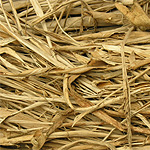
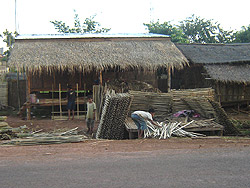 |
 |
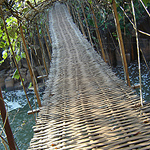
 |


